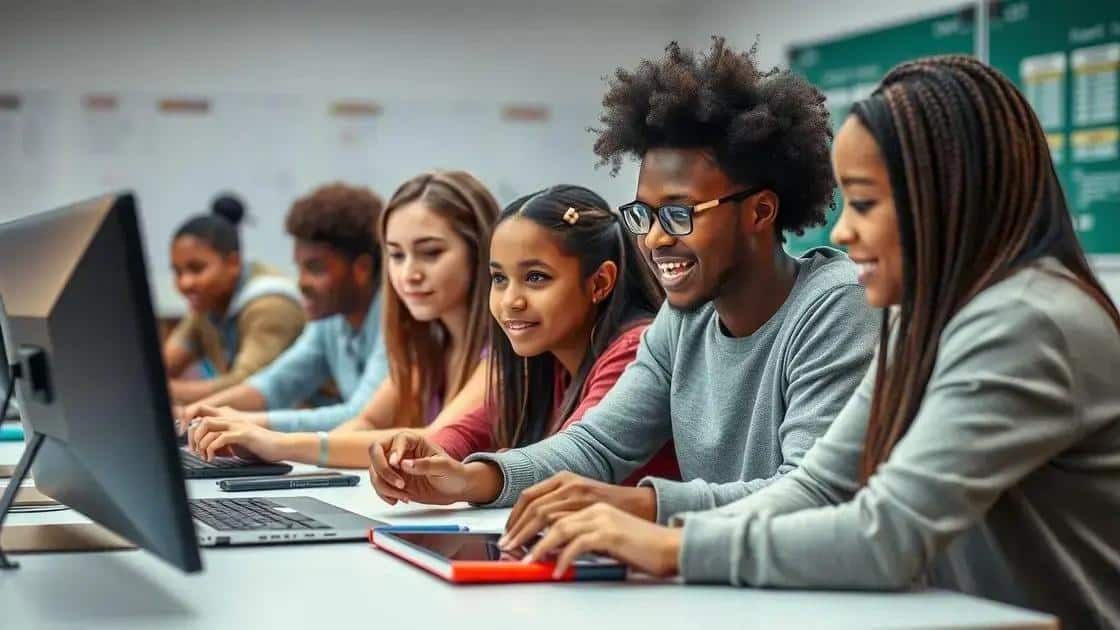Ahead education reform insights: what’s next for students?

Future educational policies will prioritize equity, technology integration, and social-emotional learning, creating more effective and inclusive learning environments for all students.
Ahead education reform insights are shaping the future of our classrooms. What changes can we expect, and how will they affect students? Join us as we dive into the latest developments and their implications.
Current trends in educational reform
Current trends in educational reform are shaping how students learn and educators teach. Understanding these changes is crucial for adapting to the evolving landscape of education.
Embracing Technology
One major trend is the integration of technology into the classroom. Schools are increasingly adopting digital tools to enhance learning experiences. This includes using tablets, laptops, and interactive whiteboards.
Technology allows teachers to deliver lessons more effectively and engage students in new ways. Online learning platforms are becoming common, providing flexibility for students to learn at their own pace.
Personalized Learning
Another significant trend is the move towards personalized learning. This approach tailors education to meet the individual needs of each student. Instead of a one-size-fits-all model, educators focus on understanding students’ strengths and challenges. Personalized learning can involve:
- Customizing lessons based on student interests
- Offering varied assessment methods
- Adjusting the pace of instruction according to student progress
This trend aims to create a more supportive environment, allowing every student to thrive.
Additionally, cooperative learning is gaining traction. Students often work in groups to solve problems or complete projects. This method encourages collaboration and communication skills, which are essential in today’s world.
Focus on Social-Emotional Learning
Lastly, there’s a growing emphasis on social-emotional learning (SEL). Schools recognize the importance of developing students’ emotional intelligence alongside academic skills. Programs that support SEL help students manage emotions, set positive goals, and establish healthy relationships.
By integrating SEL into the curriculum, educators create a more well-rounded approach to student development.
Key insights from recent studies
Key insights from recent studies reveal important trends in education reform. These studies provide evidence on what methods are most effective in improving learning outcomes for students.
Innovative Teaching Methods
Many studies point to innovative teaching methods that engage students actively. For example, project-based learning has shown significant positive effects on student motivation and achievement. Students learn critical thinking and problem-solving by working on real-world projects. Another approach is flipped classrooms, where students learn new content at home and apply it in class. This method allows for deeper understanding during class time.
The Importance of Teacher Training
Another insight is the importance of comprehensive teacher training programs. Studies suggest that teachers who undergo ongoing professional development are better equipped to meet the needs of their students. Proper training helps educators implement new strategies effectively and adapt to diverse classroom environments.
Additionally, data-driven instruction is gaining attention. Teachers who analyze student performance data are more likely to identify areas where students struggle. This approach enables timely interventions and personalized support, making a significant difference in student learning.
Engaging Families and Communities
Recent studies also highlight the critical role of family and community engagement in education. Schools that establish strong connections with families see improved student attendance and motivation. Regular communication and events bring families into the learning process, creating a supportive network for students.
- Building partnerships with local organizations
- Encouraging parent involvement in school events
- Providing resources for families to support learning at home
These insights collectively show that collaborative efforts among educators, families, and communities lead to better educational outcomes. Understanding these key insights from recent studies can guide future reforms and ensure that the focus remains on student success.
Impacts of reform on student outcomes

The impacts of reform on student outcomes are crucial to understanding how changes in education can affect learning. Recent data show that effective reforms lead to improved academic performance and engagement among students.
Enhanced Academic Achievement
One of the most significant impacts of reform is enhanced academic achievement. Schools that implement changes, such as adopting new teaching methods or integrating technology, often report higher test scores.
For instance, programs focused on project-based learning have led to greater student understanding and retention of material. When students work on real-world problems, they tend to engage more deeply and achieve better results.
Increased Student Engagement
Another effect of educational reform is increased student engagement. Reforms that promote interactive learning environments create a more motivating atmosphere for students. As students participate actively in their education, they develop a love for learning. This shift can reduce dropout rates and increase attendance. Collaborative learning models allow students to interact with their peers, fostering communication and teamwork skills.
Moreover, reforms targeting social-emotional learning help students manage emotions and build positive relationships. When students feel supported, they are more likely to succeed academically. Understanding and addressing students’ emotional needs can greatly improve their overall performance.
The Role of Assessment in Reform
To gauge the impact of reforms, assessments play a vital role. Regular evaluation of student progress allows educators to adjust their approaches and ensure that all students are on track. By analyzing data, schools can identify trends and areas needing improvement. This process leads to more customized instruction and support for students.
- Frequent formative assessments help teachers monitor learning
- Data-driven decisions enhance targeted interventions
- Collaboration among educators improves instructional strategies
Understanding these impacts enables educators and policymakers to make informed decisions about future reforms, ensuring a focus on improving student outcomes through effective strategies.
Innovative practices changing classrooms
Innovative practices are changing classrooms in exciting ways. These practices aim to improve student engagement and learning outcomes. Teachers today are adopting strategies that challenge traditional education methods.
Blended Learning Environments
One effective approach is blended learning, which combines online digital media with traditional face-to-face classroom methods. This model allows students to learn at their own pace while still receiving the benefits of direct teacher interaction. In a blended learning environment, students can access resources and materials online, enabling flexibility in how they consume information.
Collaborative Learning Strategies
Another innovative practice is collaborative learning. In this method, students work together in groups to solve problems and complete projects. This fosters a sense of community and helps develop essential skills such as teamwork and communication. When students share ideas and perspectives, they gain deeper insights into the material. It also encourages them to take ownership of their learning.
- Students learn from each other
- Encourages diverse viewpoints
- Improves critical thinking skills
This collaborative spirit is nurtured through activities like peer teaching and group discussions, which enrich the classroom experience. Additionally, technology plays a significant role in facilitating collaboration. Online platforms and tools allow students to connect and work together beyond the physical classroom.
Project-Based Learning
Project-based learning (PBL) is another impactful method that engages students in real-world challenges. In PBL, students explore a topic in depth and develop solutions to practical problems. This approach not only enhances their understanding but also prepares them for the complexities of the future workforce.
By emphasizing projects that are relevant to students’ lives, educators can spark interest and motivation. Students learn to apply knowledge creatively while developing critical skills such as research, analysis, and presentation.
Incorporating these innovative practices can transform traditional classrooms into dynamic learning environments that meet the needs of today’s learners. As education continues to evolve, these practices will play a significant role in shaping the future.
Future predictions for educational policies
Future predictions for educational policies suggest a significant shift in how education will be delivered. These predictions are based on current trends and research that aim to improve the learning experience for all students. As technology and society evolve, so must our educational frameworks.
Increased Focus on Equity
One of the major predictions is an increased focus on equity in education. Policymakers recognize the importance of providing equal opportunities for all students, regardless of their backgrounds. This shift aims to address the disparities that exist in educational outcomes. Schools will likely implement policies that ensure funding equity and access to quality resources across diverse communities.
Integration of Technology in Learning
Another key prediction is the continued integration of technology in the learning process. As digital tools become more prevalent, educational policies will need to adapt to support online learning and blended learning environments. This change means schools may receive funding for technological advancements, training teachers in digital literacy, and ensuring that students have access to devices.
Technology integration also opens up new possibilities for personalized learning, where students can learn at their own pace using adaptive learning programs.
Emphasis on Social-Emotional Learning
Future educational policies are also expected to emphasize social-emotional learning (SEL). Policymakers will recognize that mental health is just as important as academic success. Schools may develop programs focusing on emotional intelligence, resilience, and interpersonal skills. This approach helps create a supportive environment where students can thrive both academically and personally.
- Implementing SEL curriculum into everyday teaching
- Training educators to support students’ emotional needs
- Encouraging community engagement in SEL initiatives
As these predictions unfold, it will be essential for schools to stay flexible and willing to adapt their strategies. With a focus on equity, technology integration, and social-emotional learning, educational policies will be poised to address the challenges of the future effectively.
In conclusion, the future of education is poised for remarkable transformations. Schools are increasingly focusing on equity, technology integration, and social-emotional learning. These changes will create more engaging, supportive, and effective learning environments. As educators and policymakers work together to implement these innovative practices, students will benefit from improved educational outcomes, preparing them for a successful future. Understanding and adapting to these trends will be essential for schools to thrive in the coming years.
FAQ – Frequently Asked Questions about Education Reform
What are the main focuses of future educational policies?
Future educational policies will likely focus on equity, technology integration, and social-emotional learning to enhance student experiences.
How does technology integration benefit students?
Technology integration allows for personalized learning, providing students with resources that enhance their understanding and engagement.
Why is social-emotional learning important in schools?
Social-emotional learning is essential because it supports students’ emotional health, helping them develop skills to manage emotions and build relationships.
What role do collaborative strategies play in education?
Collaborative strategies encourage teamwork and communication among students, improving their problem-solving skills and boosting engagement in learning.






